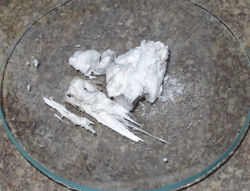Boron trioxide

| |
| Names | |
|---|---|
| IUPAC name
Boron trioxide
| |
| Other names
Boria
Boric anhydride Boric oxide Boron sesquioxide Diboron trioxide | |
| Properties | |
| B2O3 | |
| Molar mass | 69.6182 g/mol |
| Appearance | Hard glassy solid or white powder. |
| Odor | Odorless |
| Density | 2.460 g/cm3 (liquid) 2.55 g/cm3 (trigonal) 3.11–3.146 g/cm3 (monoclinic) |
| Melting point | 450–510 °C (842–950 °F; 723–783 K) (trigonal) 510 °C (950 °F; 783 K) (tetrahedral) |
| Boiling point | 1,860 °C (3,380 °F; 2,130 K) |
| 1.1 g/100 ml (10 °C) 2.77 g/100 ml (20 °C) 3.6 g/100 ml (25 °C) 15.7 100 g/100 ml (100 °C) | |
| Solubility | Soluble in ethanol, glycerol, methanol |
| Vapor pressure | ~0 mmHg |
| Acidity (pKa) | ~ 4 |
| Thermochemistry | |
| Std molar
entropy (S |
80.8 J·mol-1·K-1 |
| Std enthalpy of
formation (ΔfH |
-1254 kJ/mol |
| Hazards | |
| Safety data sheet | Sigma-Aldrich |
| Flash point | Non-flammable |
| Lethal dose or concentration (LD, LC): | |
| LD50 (Median dose)
|
3,163 mg/kg (mouse, oral) |
| Related compounds | |
| Related compounds
|
Boric acid Borax |
| Except where otherwise noted, data are given for materials in their standard state (at 25 °C [77 °F], 100 kPa). | |
| Infobox references | |
Boron trioxide is a glass like solid or white powder with the chemical formula B2O3.
Contents
Properties
Chemical
Boron trioxide is very unreactive. It can however be reduced to elemental boron with magnesium or aluminum powder in a thermite reaction.
Physical
When produced from boric acid, it forms as a non crystaline mass that is very hard and difficuilt to grind, forming a very fine powder when ground very similar to a solid plane of glass.
Availability
It is used in glassmaking, whether as a boron additive for making borosilicate glass or as a fluxing agent so this may be a source, however it is easy to produce from the starting materials boric acid or borax.
Preparation
Boric acid can be dehydrated above 300 degrees to form boron trioxide. Boron trioxide prepared at up to 800 degrees is a desiccant but it is slow acting if not finely powdered. Made at higher temperature it has an induction period.
Projects
- Producing boron
- Making the ester trimethyl borate
Handling
Safety
Storage
No special storage is required, storing it in closed bottles is fairly enough.